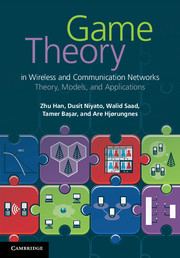Book contents
- Frontmatter
- Contents
- Preface
- 1 Introduction
- 2 Wireless networks: an introduction
- Part I Fundamentals of game theory
- 3 Non-cooperative games
- 4 Bayesian games
- 5 Differential games
- 6 Evolutionary games
- 7 Cooperative games
- 8 Auction theory and mechanism design
- Part II Applications of game theory in communications and networking
- References
- Index
5 - Differential games
from Part I - Fundamentals of game theory
Published online by Cambridge University Press: 25 October 2011
- Frontmatter
- Contents
- Preface
- 1 Introduction
- 2 Wireless networks: an introduction
- Part I Fundamentals of game theory
- 3 Non-cooperative games
- 4 Bayesian games
- 5 Differential games
- 6 Evolutionary games
- 7 Cooperative games
- 8 Auction theory and mechanism design
- Part II Applications of game theory in communications and networking
- References
- Index
Summary
The differential games framework extends static non-cooperative continuous-kernel game theory into dynamic environments by adopting the tools, methods, and models of optimal-control theory. Optimal-control theory [58] has been developed to obtain the optimal solutions to planning problems that involve dynamic systems, where the state evolves over time under the influence of a control input (which is the instrument variable that is designed). Differential games can be viewed as extensions of optimal-control problems in two directions: (i) the evolution of the state is controlled not by one input but by multiple inputs, with each under the control of a different player, and (ii) the objective function is no longer a single one, with each player now having a possibly different objective function (payoff or cost), defined over time intervals of interest and relevance to the problem. The relative position of differential games in this landscape is captured in Table 5.1 [58]. Two main approaches that yield solutions to optimal-control problems are dynamic programming (introduced by Bellman) and the maximum principle (introduced by Pontryagin) [58]. The former leads to an optimal control that is a function of the state and time (closed-loop feedback control), whereas the latter leads to one that is a function only of the time and the initial state (open-loop control). These two approaches have also been adopted in differential games, where the common solution concepts of a differential game are again the Nash equilibrium and the Stackelberg equilibrium, for non-hierarchical and hierarchical structures, respectively.
Information
- Type
- Chapter
- Information
- Game Theory in Wireless and Communication NetworksTheory, Models, and Applications, pp. 124 - 137Publisher: Cambridge University PressPrint publication year: 2011
